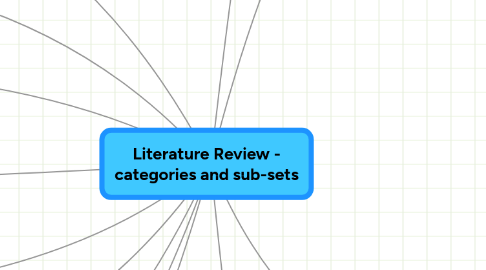
1. Methodological Review
1.1. Research Data
1.1.1. Secondary Data
1.1.1.1. External
1.1.1.1.1. Authenticity
1.1.1.1.2. Published Material
1.1.1.1.3. Online
1.1.1.1.4. Library
1.1.1.1.5. Social / Professional Networking
1.1.1.2. Internal (Organization)
1.1.1.2.1. Access Limitations
1.1.1.2.2. Non-disclosure Agreements
1.1.1.2.3. Permission / Copyright Issues
1.1.2. Primary Data
1.1.2.1. Qualitative
1.1.2.1.1. Company Interview
1.1.2.1.2. Focus Groups
1.1.2.2. Quantitative
1.1.2.2.1. Limited access to relevant people
1.1.2.2.2. Too time consuming
1.1.2.2.3. Geographical Location Issues
1.1.2.2.4. Money Constrains
1.2. Collaboration
1.2.1. Online Calendar, Groups, Document Sharing
1.2.2. Skype
1.2.3. Email
1.2.4. XML - Reference Sharing
1.2.5. MindMaster - Idea Sharing
1.2.6. Weekly student meetings
1.2.6.1. Record Meeting Minutes
1.2.6.2. Agenda Discussion
1.2.6.3. Milestone Discussion
1.2.6.4. Raising Issues / Urgency
1.2.6.5. Planning & Projecting (Timeline)
1.2.7. Academic Advisor
1.2.7.1. Emails
1.2.7.2. Sharing links to documents, resources, ideas, mindmaps, ...
1.3. Objectives
1.3.1. Understanding Issues
1.3.2. Explore pre-requisites
1.3.3. Prove / Disprove claims and role of Green IT
1.4. Motivation
1.4.1. Work Experience
1.4.2. Personal Interest
1.4.3. Voluntary Work
2. Sustainability
2.1. Definition
2.2. 3 pillars
2.2.1. Social
2.2.2. Economic
2.2.3. Environmental
2.3. Triggers
2.3.1. Degradation of environment
2.3.1.1. Waste Polution
2.3.2. Globalisation
2.3.3. Climate change
2.3.3.1. Climate
2.3.3.1.1. CO2 Footprint
2.3.3.1.2. Preservation and Prevention
2.3.3.1.3. Green House Gas Emissions
3. IT Components & Energy Consumption
3.1. IT Hardware
3.1.1. Servers
3.1.2. Storage
3.1.3. Cooling Systems (Fans)
3.1.4. Work Stations & Thin Clients
3.1.5. ChipTechnology
3.1.6. Network Infrastructure
3.2. Mobile Computing
3.2.1. Battery Life
3.2.2. Screen Efficiency
3.2.3. Geo-Computation (Satellites)
3.2.4. Life-Cycle Reduction
3.2.5. Mobile Chip Technology
3.3. Systems & Consolidation Methodologies
3.3.1. Cloud Computing
3.3.2. Network Grids
3.3.3. Remote Access
3.3.4. Virtualization
3.3.5. Internet
3.4. IT Software
3.4.1. Operating Systems
3.4.2. Planning & Design Software
3.4.3. Power Management Software
3.4.3.1. Corporate
3.4.3.2. End Users
3.4.4. Global Simulation Models
3.5. Office & Data Centres
3.5.1. A/C Cooling
3.5.2. Efficiency vs. Carbon Solutions
3.5.3. Buildings (LEED)
3.5.4. External Climate Utilization
4. Product Life-Cycle
4.1. Procurement (IPR)
4.2. Production
4.3. Distribution
4.4. Recycling & Disposal
5. Energy Concerns
5.1. Energy Sourcing
5.1.1. Oceanic
5.1.2. Hydro
5.1.3. Solar
5.1.4. Processed Energy (BTU)
5.1.5. Clean vs. Dirty Energy (Peak Time Energy)
5.1.6. Infrastructure
5.1.6.1. Reliability
5.1.6.2. Smart Grid
5.1.6.3. Scalability
5.1.6.4. Convergence
5.2. Energy Storage
5.2.1. Hydro
5.2.2. Batteries
5.2.3. Water Reservoirs
5.2.4. Air Compression
5.2.5. Carbon-Capture
6. Economy
6.1. Job Creation
6.2. Business Opportunities
6.3. Standard of Living
6.4. Spending
6.5. Market Intricacy (Globalization)
7. Business Models
7.1. Business Processes
7.2. Departmental Accountability
7.2.1. Key Performance Indicators
7.2.2. Energy Performance
7.3. Regulation Adherence
7.4. Business Reputation
7.4.1. Brand
7.4.2. Marketing
7.5. Commitment
7.5.1. Top-Down
7.5.2. Budgets
7.5.3. Company Values
7.6. Mergers & Acquisitions
7.7. Collaboration
7.7.1. Client Relationship Management (Partner Relationship)
8. Policies & Best Practices
8.1. Government
8.1.1. GDP
8.1.2. Tax Incentives
8.1.3. Certifications
8.1.4. Energy Pricing (Outside of Scope)
8.1.5. Emissions Trading Scheme (US?)
8.2. Independent Organizations
8.3. Companies & CSR
9. IT Developments & Trends
9.1. New Technology Development
9.1.1. Monitoring Systems
9.2. Accessibility (Out of Scope)
9.2.1. Infrastructure Requirements
9.2.2. Developing Countries
9.3. Awareness
9.3.1. Web 2.0 / Internet
9.3.2. Perception (Consumer vs. Executive)
9.3.3. Behavioural Changes
9.3.4. Labeling & Certifications
10. IT
10.1. IT & Climate Change
10.1.1. Awareness
10.1.1.1. Consumer behaviour
10.1.1.2. Corporate Social Repsponsibility
10.1.2. Strategy integration
10.1.2.1. Green business model
10.1.2.2. Cost cutting measures
10.1.3. Economic downturn
10.2. Need for Green IT
10.2.1. Industry growth
10.2.1.1. Carbon emission
10.2.1.2. Opportunities and challanges
10.2.1.2.1. Cost reduction
10.2.1.2.2. Energy consumption
10.2.1.2.3. Waste reduction
10.2.1.2.4. Environmental limitations
10.2.1.2.5. Business sense
10.2.2. Climate change
10.3. Efficiency
10.3.1. Energy demands
10.3.1.1. Development of technology
10.3.1.2. Data centres
10.3.1.2.1. Consumption
10.3.1.2.2. Counter-measures
10.3.2. Research & Development
10.4. PDLC
10.4.1. Recycling
10.4.1.1. e-Waste
10.4.1.2. Toxic components
10.4.1.3. Sourcing
10.4.2. Life-cycle effects
10.4.2.1. Secondary markets
10.4.2.2. Partnership approach within value chain
10.4.3. Energy dispersion within PDLC
10.4.4. Regulation and incentives
10.4.4.1. US trends
11. Green Technologies
11.1. Trends & Indicators
11.1.1. Energy costs
11.1.2. IT 1.0
11.1.2.1. Technologies
11.1.2.1.1. Energy market
11.1.2.1.2. Maturity stage
11.1.2.1.3. Eco-system equillibrium
11.1.3. IT 2.0
11.1.4. Eco-rating
11.2. Energy demands
11.2.1. Data centres & office buildings
11.2.1.1. Energy sourcing
11.2.1.1.1. Hydropower
11.2.1.1.2. Solar heating & cooling
11.2.1.1.3. Wind Energy Systems
11.2.1.1.4. Ice Energy Systems
11.2.1.1.5. Ocean Energy Systems
11.2.1.1.6. Geographic DC locations
11.2.1.2. LEED
11.2.1.3. Renewable energy purchasing
11.3. IT Hardware
11.3.1. Thin clients
11.3.2. Energy & performance measuring unit
11.3.3. Mainframes & Supercomputers
11.3.3.1. Applications
11.3.3.1.1. Research & Development
11.3.3.1.2. Climate
11.3.3.2. Storage
11.3.3.2.1. Technologies
11.3.3.3. Power management
11.3.3.4. Computing cycle
11.3.4. Data centres
11.3.5. Data De-Dublication
11.3.6. Virtualization
11.3.6.1. Virtualization levels
11.3.7. Multi-Processors
11.4. IT Software
11.4.1. Hardware inter-dependencies
11.4.1.1. Monitoring
11.4.2. Applications and programs
11.4.3. Simulations
11.4.4. Collaboration
11.4.4.1. Web 2.0
11.4.4.2. Web 3.0
11.5. Mobile computing
11.5.1. Chip technology
11.5.1.1. Energy consumption
11.5.1.2. Heat reduction
11.5.2. Productivity
11.5.3. Display technology
11.5.4. Battery life
11.5.5. Applications
11.5.6. Power supply
11.6. Systems, Frameworks, Methodologies
11.6.1. ITIL
11.6.1.1. Service quality
11.6.1.2. Continual improvement
11.6.1.3. Capacity management
11.6.1.4. Configuration management
11.6.1.4.1. Configuration Items
11.6.1.4.2. CMDB
11.6.2. Management Information Systems
12. Sustainability
12.1. Definition & concept
12.2. Three pilars
12.2.1. Economic aspect
12.2.1.1. Production and consumption
12.2.1.2. Employment
12.2.1.3. Growth
12.2.2. Social dimension
12.2.2.1. Human capital
12.2.2.2. Social capital
12.2.2.3. Cultural diversity
12.2.3. Environmental sphere
12.2.3.1. Biodiversity
12.2.3.2. Natural resources
12.2.3.3. Climate Change
12.2.3.3.1. Greenhouse effect and CO2
12.2.3.3.2. Growth and CO2 levels
12.3. Some triggers
12.3.1. Economic development
12.3.2. Globalisation
12.3.3. Climate Change
12.3.3.1. United Nation Framework Convention on Climate Change
12.3.3.1.1. Kyoto Protocol
12.3.3.1.2. US policy
13. Green IT business impact
13.1. Legislation and certifications
13.1.1. Emission trading scheme
13.1.2. Certifications
13.1.2.1. Waste
13.1.2.2. Power efficiency
13.1.3. Carbon tax
13.2. Green IT Management
13.2.1. Business value chain
13.2.2. Responsibility
13.2.2.1. RACI
13.2.2.2. Middle Management
13.2.2.3. Board of Director
13.2.3. Communication
13.2.3.1. Marketing tool
13.2.3.2. Clients as partners
13.2.4. Governance and reporting
